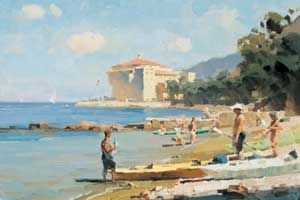
By Bonnie Gangelhoff
When the Chinese government ordered Calvin Liang to work on a communal farm feeding cows, the teenager wondered if his dreams of becoming an artist were shattering before his eyes. His hands throbbed at the end of the day, and his spirit was so weary that it was difficult to approach his sketchpad with any verve. But he was young, and his passion for art blazed strong enough to keep his dream alive.
Today, at 44, Liang has traveled far from his homeland and perhaps even further from tending bovines in the southern China countryside. On this night, more than 25 years later, Liang beams with satisfaction as he stands in a conversational knot of art lovers at the California Art Club’s Gold Medal Juried Exhibition. Nearby, his painting SAILBOATS IN NEWPORT BEACH hangs on the wall of the Pasadena Museum of California Art. The piece boasts a red dot—a collector bought the painting before the doors to the reception even opened. The signature Liang seascape depicts a gathering of sailing sloops basking in the warm Southern California sun. The canvas is dappled with splashes of gold, blue, and white, which converge to create a romantic and expressionistic scene.
Liang has won a number of awards for his painterly renderings of the sea, including honors at the annual Oil Painters of America show and the Laguna Beach Plein Air Painting Invitational. Popular with collectors, he is a busy man these days. As this story was going to press, the California painter was preparing for two upcoming exhibitions—the International Masters of Fine Art show at Greenhouse Gallery in San Antonio, TX, and a group show at Tirage Art Gallery in Pasadena, CA. “There are some paintings you hang on the wall and they attract universal attention,” notes Jim Janes, one of the owners of Greenhouse Gallery. “Calvin is one of those [artists]. Collectors who don’t even have any interest in California coastal scenes stop and look at them.”
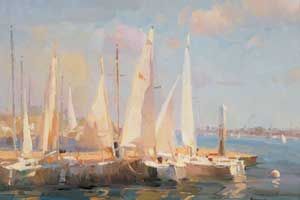 The fact that his paintings are so appealing to collectors lately has given Liang the freedom to devote his talents to a full-time career in fine art. He left a top animation job on Nickelodeon’s hit children’s television show SpongeBob SquarePants just two years ago, and his bosses tried to lure him back recently to work on a feature-film version. It was a tempting proposal, Liang admits, but life is going too well in the fine-art world to return to animation. At times, he feels a little nostalgic for the series—he created Painty the Pirate, the familiar image of a framed portrait with a human mouth that opens every show, and helped create the backgrounds for SpongeBob’s many underwater adventures.
The fact that his paintings are so appealing to collectors lately has given Liang the freedom to devote his talents to a full-time career in fine art. He left a top animation job on Nickelodeon’s hit children’s television show SpongeBob SquarePants just two years ago, and his bosses tried to lure him back recently to work on a feature-film version. It was a tempting proposal, Liang admits, but life is going too well in the fine-art world to return to animation. At times, he feels a little nostalgic for the series—he created Painty the Pirate, the familiar image of a framed portrait with a human mouth that opens every show, and helped create the backgrounds for SpongeBob’s many underwater adventures.
But fine-art fantasies die hard when they have been embedded since childhood. And so just as Liang left the farm during Mao Tse-Tung’s Cultural Revolution to pursue a painting career, so he also parted ways with the loveable talking sponge and his supporting cast members, Squidward Tentacles and Eugene H. Krabs.
To understand how Liang’s art career began, flash back for a moment to 1979 when he heard about an opportunity to study set design at China’s Canton Opera Institute. An entrance exam for the program included painting a still life from a tableau set up by the school. Twenty eager would-be artists tried out, but only two were chosen, and Liang was one of them.
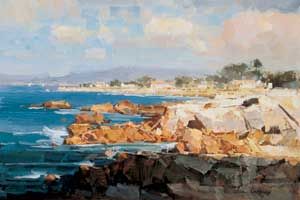 The institute eventually sent him to study at the Shanghai Academy of Fine Arts for two years. For the following six years Liang designed and painted opera sets, usually landscapes depicting the Chinese countryside. In 1987, he applied to the Academy of Fine Art in San Francisco, CA, where he soon continued his studies. He received a student visa, Liang recalls, but at the time he knew little about life in the United States beyond what he gleaned from watching old Ingrid Bergman movies and listening to John Denver tunes. “China was closed, and there was no window to the world,” he says.
The institute eventually sent him to study at the Shanghai Academy of Fine Arts for two years. For the following six years Liang designed and painted opera sets, usually landscapes depicting the Chinese countryside. In 1987, he applied to the Academy of Fine Art in San Francisco, CA, where he soon continued his studies. He received a student visa, Liang recalls, but at the time he knew little about life in the United States beyond what he gleaned from watching old Ingrid Bergman movies and listening to John Denver tunes. “China was closed, and there was no window to the world,” he says.
On the journey to America, Liang flew from Hong Kong to San Francisco, an experience that remains vivid in his mind to this day. “A half-hour before landing, the pilot told us to look down and see the ocean,” he recalls. “It was around noon when I looked out the window and saw the Pacific with the city of San Francisco all around it. I thought to myself, ‘This is a dream come true.’”
When he arrived in San Francisco, Liang’s English was poor, he remembers, and so was his wallet. To support himself, he became a street artist, spending his days painting portraits of tourists flocking around Fisherman’s Wharf and selling them for $5 each. In his spare time he also created cartoons for Marine World and devoted time to his fine-art work.
Eventually, Liang began setting up his easel and painting on the streets of San Francisco. In 1988, he sold his first fine-art piece. He had no idea how much to charge the customer, so he asked her, “How much you want to pay?” She replied “$75” and walked off with a 12-by-16-inch Liang cityscape.
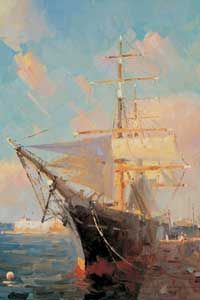 Meanwhile, the artist’s English improved—he took classes every day for five years—and his artworks began to sell more consistently, too, particularly after he joined an artists’ guild in the Bay Area.
Meanwhile, the artist’s English improved—he took classes every day for five years—and his artworks began to sell more consistently, too, particularly after he joined an artists’ guild in the Bay Area.
In 1997, Disney, impressed with his talent for color, offered Liang a position creating background animation for films such as The Little Mermaid. So the artist packed his bags and moved to Los Angeles. A few years later, his rising animation career led him to Nickelodeon for what turned into a five-year stint with the SpongeBob show.
Today, Liang is living out the fantasy of his youth. He travels regularly up and down the California coast with his sketchbook and camera, searching for subject matter from Dana Point to Monterey Bay. He often begins a painting on location to capture the fleeting light and color, but typically 70 percent of the work is finished in his studio.
Although Liang has painted a variety of subject matter, he is most passionate about capturing scenes involving the Pacific Ocean. “I love the smell, the color, and the sounds of the waves—every single wave is a different shape,” Liang says. “I am so relaxed and happy the moment I see the ocean.”
When Liang isn’t painting, he rents a power boat and explores the coastline. He once tried to set up an easel and paint on board but says it was hopeless because he started to feel seasick. Boats frequently appear in Liang’s coastal renderings. He has been fascinated with the shape and movement of them since he was young, viewing everything from tall ships to sailboats as royalty of sorts. This accounts, in part, for his frequent portrayal of vessels in a regal fashion, with white billowing sails, expansive hulls, and towering masts.
Liang plans to fly back over the Pacific Ocean someday to visit his native China for the first time since he left—perhaps when his 5-year-old son, Lawson, is older, he muses. His son’s name, loosely translated, means “born in Los Angeles” in Chinese. At least Lawson probably won’t have to change his name like his father. When Liang arrived in San Francisco and applied for a social security card, his friends told him to choose an English name to replace his given name, Ge. They thought it would make life in America easier and proceeded to suggest names like Tony or William as suitable replacements. “I didn’t like those names,” Liang recalls. Finally, someone suggested Calvin. “I had no time to choose,” he says. “I finally said OK for Calvin, and I didn’t even know how to spell it.”
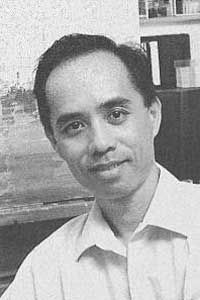 When Liang tells such stories about past struggles, he displays his trademark upbeat nature, shaking his head and grinning. He seems genuinely grateful for every iota of success. Although he has sold many paintings, he still reacts proudly when talking about his most recent sale of SAILBOATS IN NEWPORT beach. “It made me so happy,” he says. “I have wanted to do this my whole life. America has made me an artist.” o
When Liang tells such stories about past struggles, he displays his trademark upbeat nature, shaking his head and grinning. He seems genuinely grateful for every iota of success. Although he has sold many paintings, he still reacts proudly when talking about his most recent sale of SAILBOATS IN NEWPORT beach. “It made me so happy,” he says. “I have wanted to do this my whole life. America has made me an artist.” o
Liang is represented by Tirage Art Gallery, Pasadena, CA; Greenhouse Gallery of Fine Art, San Antonio, TX; Trailside Galleries, Scottsdale, AZ, and Jackson, WY; Waterhouse Gallery, Santa Barbara, CA; and Win Henstock Gallery, Laguna Beach, CA.
Featured in January 2005





